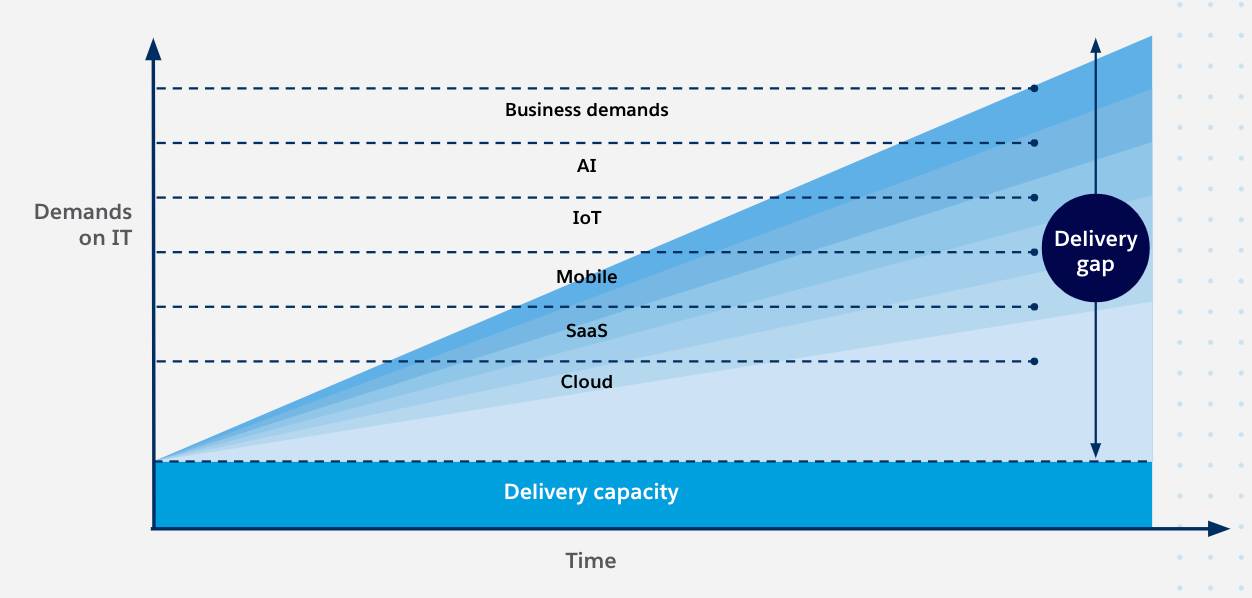Take an Enterprise Approach to Citizen Integration
Learning Objectives
After completing this unit, you’ll be able to:
- Identify the various market forces to which organizations in all industries must react quickly.
- Explain how citizen integrators are empowered to improve the delivery of IT projects.
- Explain how to optimize citizen integration architecture.
You’ve already learned how, across every industry, organizational leaders are experiencing a wave of market forces that are impacting all channels of their businesses (face-to-face interactions, call centers, web, mobile, and so on). Whether these involve competitive forces, pandemics, economic shifts, regulatory activity, or even something great but self-inflicted like the unanticipated success of a new customer offering, those same leaders don’t have the luxury of time to adjust. The reaction must be swift, impressive, and calibrated for growth. Maintaining the status quo is not enough.
Welcome to the new normal. Not only that, gone are the days when organizations could rely on analog countermeasures to cope with these ever-shifting market conditions. Responses must be mostly if not entirely digital in nature, which in turn puts an organization’s digital experts—the CIO and IT department—on the spot to deliver secure, scalable solutions in record time.
No pressure, right? Actually, not right.
While it’s one thing to envision the sort of innovative digital initiatives that can deliver an organization from the jaws of one or more stressful market shifts, it’s another to attempt reliance on the old operational model of making the IT department responsible for the fix. Recall from the first unit of this module that, for a majority of organizations, the demands of the business have already outstripped the capacities of their IT departments. In graphical terms, the breakage of that tired old operational model looks like this.

The chart shows how, over time, as the business looks to IT to help with all of its demands (ranging from cloud oversight to artificial intelligence-based innovation and more), the backlog versus IT’s relatively fixed capacity turns into a seemingly insurmountable delivery gap. With no major infusion of new IT resources on the horizon, especially given the uncertainties of today’s economic climate, the only answer is to consider a very different operational model. One that, through scalably architected citizen integration tools that do their bidding with clicks instead of code, recruits lesser technically inclined personnel from across the business (like Ashley Wiggins from NTO in the previous unit) to assist with the ever-widening delivery gap.
As the old saying goes: Give a man a fish and you feed him for a day. Teach a man to fish and you feed him for a lifetime. Even better, those potential citizen integrators say they’re up for the challenge. According to a survey of over 1,700 line-of-business managers working at organizations of 250 people or more, over half of the respondents believed that, given the right self-service tools for quickly and easily unlocking data assets, they themselves could bear some of the responsibility for delivering innovative applications and customer experiences.
In other words, they’re ready to go fishing!
Provided your organization is ready to consider this new operational model, the next big question is what to look for in a world-class citizen integration tool.
Enterprise-Class Citizen Integration Tools Depend on Enterprise-Class Architecture
Put yourself in the shoes of a sales operation manager with no IT background, like Ashley from the previous unit. Ashley probably doesn’t view herself as having been deputized as part of an army of citizen integrators who are helping with that delivery gap. Ashley just has a job to do and saw the opportunity to automate a task that required some integration between two different systems. To create her automation, Ashley could have turned to one of the several consumer-grade automation websites that offer a menu of prebuilt integrations.
But, early on, the IT department realized that in order for NTO to truly benefit from the idea of citizen integration, it had to more holistically view the citizen integration platform as an integral part of the company’s broader aspirations to become an API-led composable enterprise.
Recall from the first unit how important it is to envision organizational capabilities and competencies as reusable digital building blocks that drive operational efficiency and help close the delivery gap. When APIs fuel this sort of repeated consumption—where developers and citizen integrators alike are composing different applications out of the same reusable assets—the organization is on its way to being a fully composable enterprise.
Whether she knew or not, when Ashley integrated Salesforce Sales Cloud’s configure, price, quote (CPQ) capability with NetSuite’s inventory management capability in the previous unit, she was assembling a new business process out of reusable API-based digital building blocks that NTO’s IT department made available to her and other citizen integrators through MuleSoft Composer.
But under the hood of MuleSoft Composer, the APIs that Ashley and her colleagues are reusing by virtue of Composer’s clicks-not-code user interface are the same APIs that developers elsewhere within NTO can use to compose more complex applications.
By architecturally enabling both its citizen integrators and its developers through the same APIs, NTO not only starts to achieve its vision of agility and efficiency by maximizing reusage (while also deputizing those citizen integrators to close the delivery gap), it gets to scale its existing investments into the management, security, governance, implementation and promotion of those APIs across both types of consumers.
For example, any enterprise security policies that are applied to an API at the API management level are automatically inherited by both developers and citizen integrators. The situation would be quite different and far less manageable if citizen integrators were enabled with separately considered tools that don’t take the bigger enterprise architecture and vision into account.